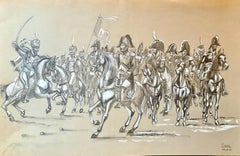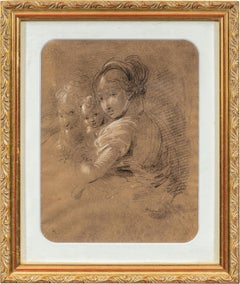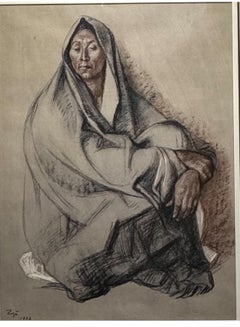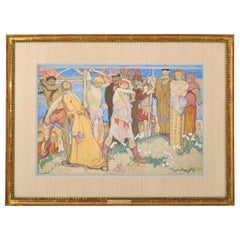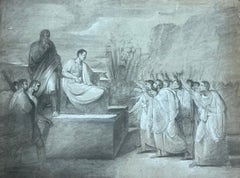Chalk Figurative Paintings
Late 20th Century Outsider Art Chalk Figurative Paintings
Chalk, Crayon, Cardboard, Pencil, Watercolor
Early 19th Century Baroque Chalk Figurative Paintings
Paper, Chalk, Pencil
1970s Abstract Expressionist Chalk Figurative Paintings
Charcoal, Chalk, Mixed Media
1910s Art Nouveau Chalk Figurative Paintings
Chalk, Charcoal, Watercolor, Gouache, Pencil
18th Century Old Masters Chalk Figurative Paintings
Chalk, Charcoal, Pencil
1990s Abstract Expressionist Chalk Figurative Paintings
Paper, Conté
Mid-20th Century Outsider Art Chalk Figurative Paintings
Chalk, Crayon, Watercolor, Cardboard, Pencil
Early 18th Century Old Masters Chalk Figurative Paintings
Chalk
2010s Contemporary Chalk Figurative Paintings
Canvas, Chalk, Pastel, India Ink, Graphite
Late 20th Century Outsider Art Chalk Figurative Paintings
Chalk, Crayon, Watercolor, Pencil
21st Century and Contemporary Expressionist Chalk Figurative Paintings
Resin, Chalk, Oil, Wood Panel, Graphite
1950s French School Chalk Figurative Paintings
Paper, Chalk, Charcoal
1940s Chalk Figurative Paintings
Chalk, Gouache
2010s Contemporary Chalk Figurative Paintings
Paper, Acrylic, Terracotta, Conté, Charcoal, Mixed Media, Washi Paper
2010s Contemporary Chalk Figurative Paintings
Canvas, Chalk, Acrylic
1720s Old Masters Chalk Figurative Paintings
Chalk
1920s Art Deco Chalk Figurative Paintings
Paper, Chalk
1920s Art Deco Chalk Figurative Paintings
Paper, Chalk
20th Century Contemporary Chalk Figurative Paintings
Paper, Conté, Color Pencil
1920s Modern Chalk Figurative Paintings
Paper, Ink, Pen, Conté
2010s Contemporary Chalk Figurative Paintings
Conté, Charcoal, Paper
21st Century and Contemporary American Impressionist Chalk Figurative Paintings
Paper, Chalk, Charcoal
Early 2000s Contemporary Chalk Figurative Paintings
Canvas, Mixed Media, Conté, Oil
21st Century and Contemporary Chalk Figurative Paintings
Canvas, Chalk, Ink, Tempera, Graphite
1990s American Modern Chalk Figurative Paintings
Acrylic, Rag Paper, Conté
21st Century and Contemporary Expressionist Chalk Figurative Paintings
Resin, Chalk, Oil, Wood Panel, Graphite
1990s American Modern Chalk Figurative Paintings
Conté, Acrylic, Rag Paper
21st Century and Contemporary Chalk Figurative Paintings
Chalk, Pastel
21st Century and Contemporary Expressionist Chalk Figurative Paintings
Resin, Chalk, Oil, Wood Panel, Graphite
2010s Contemporary Chalk Figurative Paintings
Chalk, Paper, Pastel
2010s Contemporary Chalk Figurative Paintings
Paper, Pastel, Conté
21st Century and Contemporary Expressionist Chalk Figurative Paintings
Resin, Chalk, Oil, Wood Panel, Graphite
1920s Modern Chalk Figurative Paintings
Paper, Conté, Ink, Pen, Pencil
2010s Contemporary Chalk Figurative Paintings
Chalk, Pastel, Paper
2010s Contemporary Chalk Figurative Paintings
Paper, Conté
2010s Modern Chalk Figurative Paintings
Paper, Mixed Media, Conté, Charcoal
Early 2000s Modern Chalk Figurative Paintings
Pastel, Board, Paper, Conté, Tempera
Early 1900s Chalk Figurative Paintings
Chalk, Charcoal, Paint, Paper
2010s Contemporary Chalk Figurative Paintings
Paper, Conté
2010s Contemporary Chalk Figurative Paintings
Paper, Conté, Pastel
2010s Contemporary Chalk Figurative Paintings
Paper, Conté, Pastel, Mixed Media
2010s Abstract Chalk Figurative Paintings
Chalk, Oil, Canvas
2010s Modern Chalk Figurative Paintings
Paper, Ink, Conté
21st Century and Contemporary Contemporary Chalk Figurative Paintings
Chalk, Charcoal, Oil Pastel, Archival Paper
2010s Contemporary Chalk Figurative Paintings
Canvas, Chalk, Acrylic
2010s Contemporary Chalk Figurative Paintings
Canvas, Chalk, Acrylic
21st Century and Contemporary Chalk Figurative Paintings
Canvas, Chalk, Ink, Tempera, Graphite
2010s Contemporary Chalk Figurative Paintings
Canvas, Chalk, Acrylic
1960s American Modern Chalk Figurative Paintings
Chalk
2010s Contemporary Chalk Figurative Paintings
Canvas, Chalk, Acrylic
1920s Modern Chalk Figurative Paintings
Paper, Ink, Pen, Conté, Pencil
1920s Modern Chalk Figurative Paintings
Paper, Ink, Pen, Conté
2010s Contemporary Chalk Figurative Paintings
Chalk, Paper, Pastel
2010s Contemporary Chalk Figurative Paintings
Pastel, Chalk, Paper
2010s Contemporary Chalk Figurative Paintings
Paper, Conté, Pastel
2010s Contemporary Chalk Figurative Paintings
Paper, Pastel, Mixed Media, Conté
2010s Contemporary Chalk Figurative Paintings
Paper, Conté, Pastel, Mixed Media
2010s Contemporary Chalk Figurative Paintings
Pastel, Paper, Conté
1630s Old Masters Chalk Figurative Paintings
Paper, Chalk
2010s Contemporary Chalk Figurative Paintings
Canvas, Chalk, Acrylic
Chalk figurative paintings for sale on 1stDibs.
Read More
See Kent Monkman’s Magical Realist Take on Frontier History
With a solo show at the Denver Art Museum and a commission from the Met, the Cree Canadian painter has become an international sensation.
Cecilia Vicuña Merges Politics, Science and Spirituality in Her Poetic Art
The Chilean creator, who has been living in exile in New York for decades, is having a major moment, receiving the biggest exhibitions, commissions and awards an artist could dream of.
